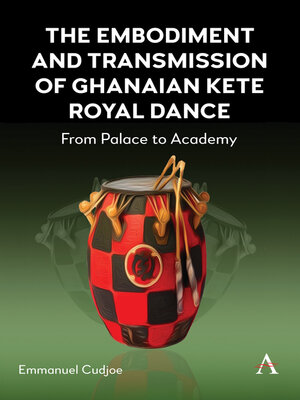The Embodiment and Transmission of Ghanaian Kete Royal Dance
ebook ∣ From Palace to Academy · Anthem Africology Series
By Emmanuel Cudjoe

Sign up to save your library
With an OverDrive account, you can save your favorite libraries for at-a-glance information about availability. Find out more about OverDrive accounts.
Find this title in Libby, the library reading app by OverDrive.



Search for a digital library with this title
Title found at these libraries:
| Library Name | Distance |
|---|---|
| Loading... |
The Kete dance form, once exclusive to royal courts, carries intricate movements, symbolic gestures, and rhythms that mirror Ghanaian history and values. It embodies storytelling, often depicting tales of bravery, unity, or significant historical events. These dances were traditionally reserved for specific occasions within the royal setting, symbolizing prestige, honor, and tradition.
With the passage of time, the transmission of Kete royal dance has transcended its original palace context, finding its way into academic domains. Universities and cultural institutions now extend the legacies of this dance form and even act as custodians of this art form, where scholars, dancers, and enthusiasts collaborate to study, preserve, and teach Kete dance.
Through meticulous documentation, research, and practice, the academy endeavors to honor the Kete dance while making it accessible to a broader audience. This transmission from palace to academy serves as a testament to the resilience and adaptability of cultural traditions. It ensures the continuity of Ghanaian heritage and allows future generations, both within and beyond Ghana, to appreciate and learn from this profound dance form from an Afrocentric perspective.
The Kete royal dance, originating from the Ashanti people of Ghana, is a cultural treasure deeply rooted in the history and traditions of the Ashanti Kingdom. This dance form, once exclusive to royal courts, has undergone a transformative journey, transcending its palace origins to find a place within academic settings.
The history of the Kete royal dance dates back centuries to the Ashanti Kingdom, where it served as an integral part of royal ceremonies, festivals, and courtly events. Originally performed exclusively for Ashanti kings and queens, the dance symbolized royal prestige, spirituality, and cultural identity. Over time, the dance gained recognition beyond the palace walls, becoming a symbol of Ashanti cultural heritage. Kete dance is a language in itself, with each movement conveying a specific message or emotion. The dance communicates narratives of Ashanti history, spirituality, and societal values. Intricate footwork, hand gestures, and facial expressions are meticulously choreographed to tell stories, celebrate victories, or express reverence. The communicative power of Kete lies in its ability to transcend verbal language, conveying rich cultural narratives through the physical language of dance. In recent decades, Kete dance has transitioned from the exclusive domain of the palace to academic institutions. Dance scholars, educators, and students have recognized its cultural significance, leading to its inclusion in dance curricula. From an Afrocentric perspective, this volume discusses the transmission of the dance to the academy and in the diaspora. It highlights not only the teaching of the physical movements but also how heritage is imparted through specific cultural and generational contexts, historical narratives, and symbolic meanings embedded in Kete.







